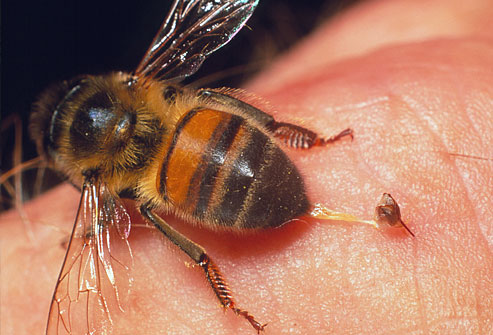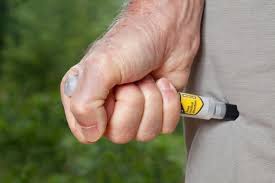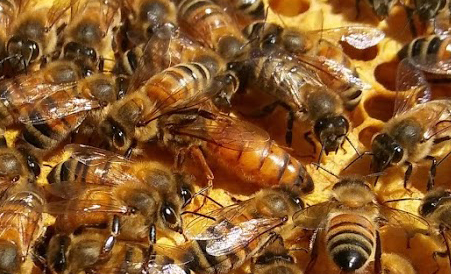If you are a beekeeper, grew up in the country or just so happened to accidentally pinch the wrong flower, you probably have some experience with a honey bee sting. After the swelling goes down and it stops itching you forget about it until it happens again, but there are some things about honey bee stings that you shouldn’t forget, and a small chance that remembering some key points can save your life. Here is all you need to know about honey bee stings.
A honey bee will sting to defend her hive or as a result of rough handling. They use stings as a last resort defense mechanism, with no inclination to sting you for any other reason. When the hive recognizes a threat, the response is first a release of an alarm pheromone, alerting the rest of the colony of the threat. The alarm pheromone is released from the honey bee’s Koschevnikov gland and consists mainly of a substance called Isoamyl Acetate, also the main ingredient in banana oil. When this scent permeates through the hive a beekeeper will normally mask it with smoke from a bee smoker, sometimes delaying or stopping the next level of defense, stings. If the threat level increases to the threshold of that particular hive, some bees will fly out, normally to an area of the invader known to be sensitive and sink their barbed stinger in a fleshy, moist tissue spot. If the invader was a mammal or bird, chances are the stinger’s barbs would serve their purpose and the stinger and venom sack would remain stuck to the victim even as the bee flies off, eviscerating the bee resulting in her death shortly thereafter. If not removed quickly, the venom sack will continue to pump bee venom into the victim, increasing the severity of the resulting reaction. The total amount of venom contained in a venom sack is thought to be about .1mg, but nonetheless, you should remove the stinger as quickly as possible after the stinging incident.


The main component of bee venom is water, this fact allows for the venom to disperse quickly and efficiently in our water rich tissue, causing the reaction to start almost immediately. Other than water there are many different components that make up the complicated solution that is honey bee venom. We will talk about the components in terms of percentages of the venom’s dry weight. That is, the percentage of the venom after water had been completely removed. Most of the remaining components are peptides, or, chained amino acids in which a carboxyl group of one is linked to the amino group of another. Put more simply, they are small proteins that react in our bodies and other biological mediums in different and interesting ways.
The most abundant of the peptides is Melittin, making up 50% of bee venom’s dry weight. Melittin causes red blood cells at the sting site to burst and blood vessels to expand causing pain and in some cases, a drop in blood pressure.
The next in line of most abundant is a substance called Phospholipase A2, making up 12% of bee venom’s dry weight. Phospholipase A2 helps destroy cell membranes at the sting site, causing pain and inflammation.
After Phospholipase A2 is Histamine, making up 9% of bee venom’s dry weight. This substance causes capillaries to leak fluid resulting in itchy, red spots.
The remaining active compounds in bee venom are Apamin – 2-3% of bee venom’s dry weight, and Hyaluronidase – 2%. Apamin destroys nerve tissue and increases the production of cortisol in the adrenal gland and Hyaluronidase helps spread the reaction by dilating capillaries and breaking down cell membranes.
There are many other components that exist in bee venom that either have a limited effect or have not been studied enough to list any general characteristics in this overview of such a complex solution.


The types of reactions after a sting or multiple stings are described as local, systemic and toxic. Local reactions are the most common, and no more harmful than the annoyance that comes with the pain and itching. In a local reaction there will be swelling and redness at the sting site, or in a large local reaction the swelling may spread, sometimes an entire limb. In both local cases the symptoms will normally diminish and eventually cease, after 24 – 72 hours. A systemic reaction is more severe, as this is not caused by the bee venom but the body’s immune system over reacting to the invading proteins. A systemic reaction can involve hives, general swelling and redness, general itching, low blood pressure and difficulty breathing. In some severe cases, anaphylaxis can occur and can result in death if not treated immediately. The third type of sting reaction is the toxic reaction. Toxic reactions are not allergic responses, rather they are direct results of the bee venom. In toxic reactions symptoms can include fever, nausea, weakness, vomiting and pain. Toxic reactions are rarely serious but can sensitize young people, increasing the risk of allergic responses in the future.
Kidney problems can arise after a major stinging incident, because the kidneys can have trouble dealing with the excess tissue damage. In severe cases kidneys can become clogged and fail in the days following a major stinging event. If you are the victim of a major stinging (normally more than 100 stings) incident, you should follow up with a physician to monitor your health for a time in case of renal failure.
Treatments of bee stings vary depending on the type of reaction. For a localized reaction, ice packs can reduce swelling and hydrocortisone cream can help to reduce the reaction’s severity. A solution of meat tenderizer and water can also help with the severity of the reaction because Papain, an enzyme in meat tenderizer, can help to break down the bee venom at the sting site. Antihistamines can help with the itching and pain relievers like ibuprofen and acetaminophen can reduce pain and swelling. Do not take aspirin for pain relief after a sting, as it will thin the blood, exacerbating the bruising, swelling and cell degradation.


In case of an allergic reaction following a sting or stings, the use of epinephrine may be necessary. Commonly known as an epi pen, although sometimes administered via syringe, epinephrine causes constriction of the blood vessels, which increases blood pressure and reduces swelling. It also increases heart rate which reduces the chance of cardiovascular failure. Epinephrine relaxes muscles that contribute to labored or reduced breathing ability and even stops the body’s release of additional allergic chemicals, which stops the progression of the reaction. It is safe to say that anyone with a known honey bee venom allergy should have some form of epinephrine handy at all times, and anyone who keeps bees should acquire it as well, whether for them or any other people near their bees.
So, those are the down sides about honey bee stings, naturally you may ask, are there any good things about being stung? Bee venom has been heralded for centuries as a miracle cure for anything from arthritis to infection, and more recently as at least a tool in the quest for eradication of HIV and Lyme Disease. As in most popular internet stories, there is a kernel of truth mixed with a bunch of unsubstantiated claims. Some of these claims are, shamefully, click-bait and some are a manifestation of the optimistic nature of humans desperate for a cure. For example let’s say we have 100 arthritis sufferers who all agree to take part in a clinical study on the efficacy of bee venom therapy for arthritis pain. They are all subjected to the same amount of venom and in the weeks that follow they report back on their pain levels. Some would notice a decrease in pain due to the placebo effect, and report back that the venom had worked. Some would undoubtedly have a reduced pain level due to natural fluctuations, and they will also report that the venom had worked. The people who did not experience any relief would report that it had not worked. After this study, the people who experienced relief would most likely tell others about the miracle they had found, spreading the thought to people who would probably believe it because they are hearing the claim from someone who actually experienced the miraculous benefits. The people who did not gain any relief from their arthritis pain would certainly not be as boisterous about the fact that it hadn’t worked as the people who were shouting about the miracle cure. This game of telephone amongst arthritis sufferers will spread the unsubstantiated claims, perpetuating the pseudo-science and maintaining a group of loyal, loquacious, supporters.


Just because some of these claims are far-fetched and less than scientifically repeatable doesn’t mean there aren’t areas in medicine where bee venom can be useful. Melittin’s unique ability to rupture cells is believed to have some potential in the fighting of bacterial infections like Lyme Disease and maybe even some ability to prevent and eliminate HIV. There are even studies being done regarding the ability of Melittin to invade and destroy cancer cells. Some people think that the anti-inflammatory characteristics of some bee venom components may have some use in the fight against nerve, tissue and even, yes, arthritis pain. So, the jury is still out on what ailments this enigmatic solution can help us with. Almost certainly at some point in the future there will be bee venom components in medicinal treatments for one thing or another, exactly what and how, I do not know. I think to make claims more certain than that at this time is irresponsible.
The bottom line is, the honey bee is not out to get you, your puppy or your neighbors. If you see one foraging on your porch flowers, let her be, she is more than happy to completely ignore you, she has work to do, you see? You may be nervous about beehives in your neighborhood, and if you have an allergy or think your child might have one, you would be smart to take precautions, but trust me, more bees in the area does not mean more stings. In reality, it means more flowers, fruit, vegetables and probably a neighbor with a jar of honey for you come Christmas time. And remember, only 5% of the population will exhibit any type of allergic reaction and only a fraction of those will experience something as severe as anaphylaxis in response to a honey bee sting. So please, don’t be afraid, that bee has more important things to than to give you a bad day.
References :
Bee Culture – Bee Venom Chemistry
National Library Of Medicine – Apitoxin
University of California San Diego – Honeybee Aggression
DrGreene.com – Treatment Of Bee Stings

